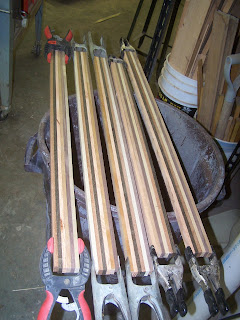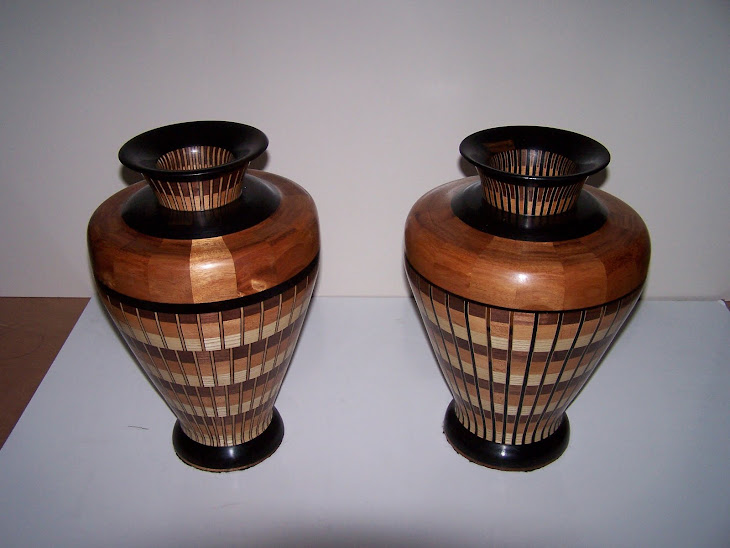MGDL
or
Fun with Diamonds
Diamonds may be a
girl's best friend but the wood worker's among us can have lots of fun with
projects using diamonds to make dynamic wood art.
Multi Generational
Diamond Lamination (MGDL) is the process of gluing multiple first generation
laminations into both vertical and circular design patterns.
Believe it or not
these designs are made with the same material and with the same construction
method. The diamond orientation differs, but the parts and pieces are the same.
On the left you see the vertical or linear orientation and on the right a
circular design. The difference from top to bottom is simply different
finishing techniques which can be employed. These 4 designs represent a small
fraction of what is possible in variation and expression in the endless array
of designs possible using this technique. While working on one design I am
taking notes on the next 4 projects I want to try.
With these lamination
projects we are focusing not on making something in particular rather, we are
'making something to make something'. To create the above material is a
wonderful beginning to a beautiful .....
whatever. Whether lazy Susan, cutting board, platter or a vase, bowl or
plate all would be fitting uses for this wonderful, colorful material. For all
woodworkers whether you have a lathe or not, this type of project is nothing
but fun. For our purposes we will focus on the making of these blanks above and
allow the wind to carry your application of it where it will. I beg you though,
comment and let me know how you were able to apply these techniques.
First we need to
determine how many varied colors and wood types to involve. I have chosen 6 for
this project but 4 is a better number to start with as with my first try at
this seen above. Here the diamonds are larger and easier to work with but it
uses 4 types of wood with the same basic circular 8 pointed star pattern.
As with all these types of projects its
success is centered on all the material being the same width and thickness.
Also best results come from using wood with a similar density and relative
hardness. Combining poplar or pine with Iron wood or purple heart is not
recommended. The material must be spot on in dimensions and be sure and make up
twice as much as you think you'll need.
Above you see I have
milled up cherry, ash, walnut, black locust, Brazilian cherry and Brazilian
walnut. The more contrast in the wood the better the woods augment each other
and the designs stand out.
With the material
milled we can begin to make the first generation lamination. These six are
laminated together as below.
Notice here that each lamination is different.
Each one in sequence moves the top most wood to second position and the bottom
wood to the first position. Thus you are making six sequenced laminations. Follow
the darkest wood and you will see that with each of the six glue-ups it is in a different position. They are ordered
in a step fashion.
Now that our material
is ready let's get started.
What is a diamond?
There are many ways to answer that question but for our purposes, diamonds
share a common length along each of its 4 edges, like a square whose top has
been pushed over by the wind. Now this sounds easy but it is not. In order to
accomplish this you need to pay close attention to the width of the material
because the width will determine the length of the 2 edges which are along the
cut or mitered sides.
Your project will be
determined by the center set of diamonds in the round. Like building any round
object we begin from the center and work out. Here we are looking at 8 diamonds
all pointed to the center. 8 divided by 360 degrees is 45. So each piece will
contain 45 degrees. Since each diamond has 2 sides which connect on the edges
moving towards the center we will divide the 45 degrees evenly for a diamond
with all its edges at 22.5 degrees. That is pretty much the end of the math.
This math can apply to any number of center pieces. For example , 10 center
pieces at 36 degrees each with cuts at 18 degrees. The difficulty is in getting
a perfect cut from your table saw miter jig or your miter saw. Practice and cut
scrap until you have a perfect 8 pointed star with no gaps or spaces on the
interior or exterior. Remember , cumulative error is to be avoided, so the time
you spend getting it cut just so , pays off down the road.
Once our miter is
ready we can begin cutting diamonds 6 at a time.
Weather table saw or
miter box this process must be precise and consistent. Uniformity is the key.
that we are more
comfortable with the design we can get the glue bottle out. We begin with a
diamond of diamonds. With all projects like this it is always best to glue in
stages and steps. In this case, larger diamonds.
Notice the rubber
bands and glue boards. Because the shape of a diamond will not support glue
pressure on its pointed ends these 'outriggers' so to speak are necessary
Above the finished diamonds form the linear
pattern
Beginning to take
shape
And here you have it. It is important to trim
the unfinished 2 edges to make these stars come together perfect. A miter or
table saw jig work well for this as will a disk sander.
Care must be taken
maintain the exact 22.5 degrees and not to remove so much material as to
disrupt the overall design pattern.
In the interests of
time and space and knowing a picture is worth well over a thousand words,
especially to a wood worker I will show more and talk less.
A dry fit up showing both finishing techniques. One with a continuation of the linear pattern and the other with a simple section of material cut to fit.
I have found the best
way to finish and flatten these is to use a belt sander.
I hope you have found
this posting helpful in opening up new dimensions in woodworking. It is one of
the most fun projects I have enjoyed for some time. Remember if you try it be
sure and let me know how you did.
Always gluing
something:
Steve




































Extraordinary work !!!! Thanks for the pictorial.
ReplyDeletemind blowing and beautiful work.. I Salute
ReplyDeleteGreat work. We are also a leading manufacturer of lathe machines in India.
ReplyDeleteThis has been a so interesting read, would love to read more here….
ReplyDeleteBrazilian Walnut
Very interesting will give it a try
ReplyDeleteThankyou
John